Purpose and Necessity of Quality Management in the Health Care Industry
- Based on Total Quality Management thinking:
- Enabling clinicians and managers to analyze and improve care delivery processes;
- Adopting a standard that customer needs are the main determinants of quality;
- Developing a multidisciplinary approach beyond traditional ones;
- Offering motivation for a rational evidence-based cooperative methodology to process analysis and change (Balasubramanian, 2016).
- To address health care challenges:
- Increasing in the cost of health services;
- Adapting to rapidly growing technologies;
- Decreasing costs and improve quality;
- Satisfying patients’ needs – high expectations;
- Low adherence to care;
- High rates of adverse events (Moraros, Lemstra, & Nwankwo, 2016; Al-Shdaifat, 2015).
TQM is considered a management approach with two main viewpoints, namely a “management philosophy and a management method” (Balasubramanian, 2016, p. 271). Hence, four unique roles seen as the essence of good management have been identified:
- Empowering clinicians and managers to analyze and improve process;
- Adopting a norm that customer preferences are the primary determinants of quality and the term “customer” includes both patients and providers in the process;
- Developing a multidisciplinary approach which goes beyond conventional departmental and professional lines;
- Providing motivation for a rational data-based cooperative approach to process analysis and change (Balasubramanian, 2016, p. 271).
Researchers have identified challenges facing the healthcare system as the rising cost of health services, adapting to rapidly growing technologies, and satisfying patients’ needs using both TQM and Lean interventions (Moraros et al., 2016; Al-Shdaifat, 2015). Continuous Quality Improvement is required to address these challenges.
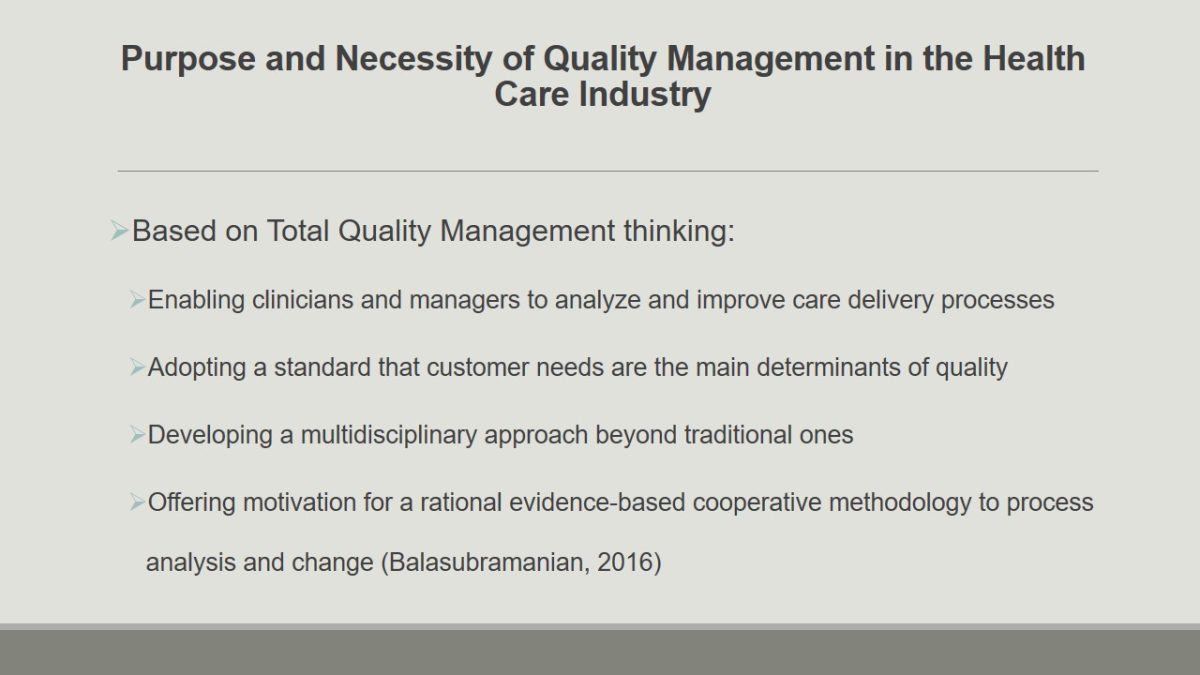
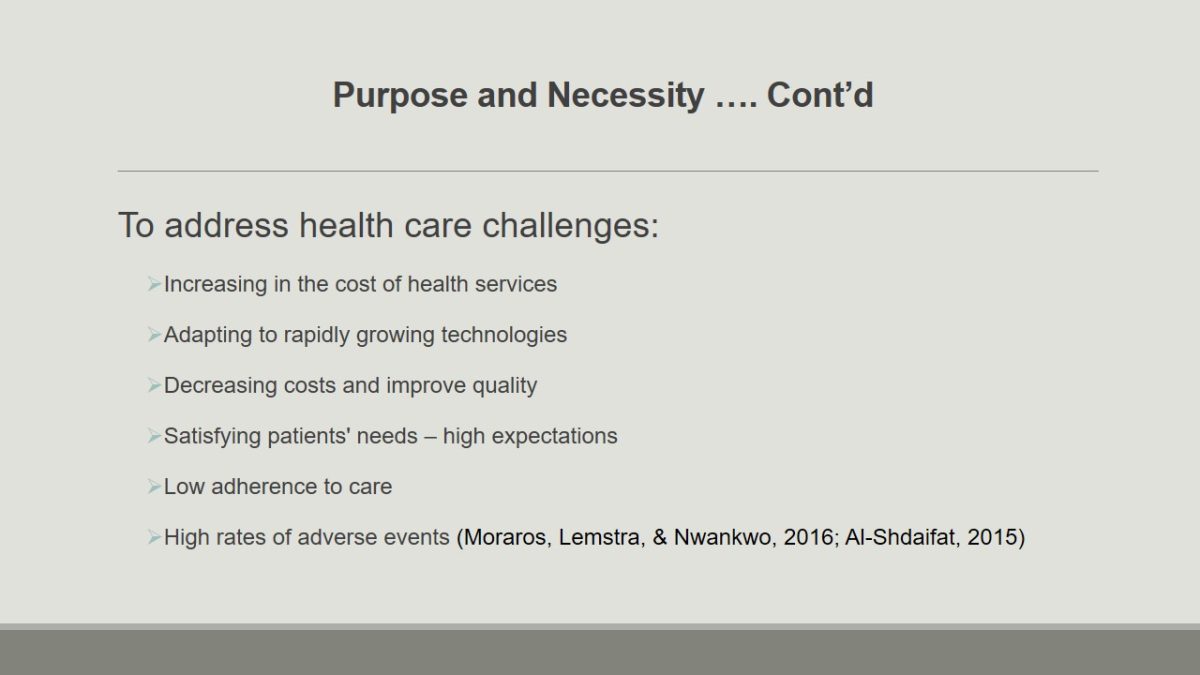
Various Health Care Stakeholders
- Political and healthcare leaders (policymakers and decision-makers);
- The public;
- Patients and their family members;
- Clinicians and physicians;
- Vendors.
Health care setting consists of various stakeholders with diverse roles and needs. Political and healthcare leaders (policymakers and decision-makers), the public, patients and their family members, clinicians and physicians, and vendors are major stakeholders who significantly influence the quality of healthcare delivery, and they may advocate for change to improve quality of care (Moraros et al., 2016).
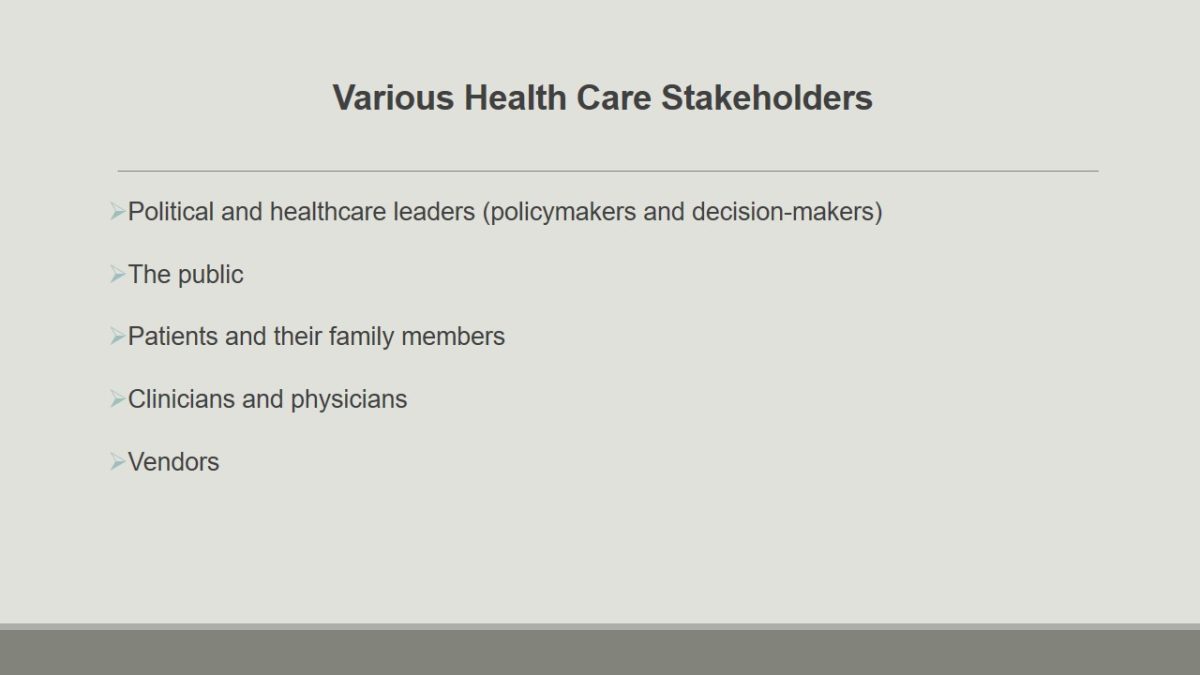
Why Quality of Care Definitions Differ
- Definitions of care are based on:
- Likelihood of desired health outcomes.
- Current professional knowledge.
- Aspects of care being assessed.
- Clinical indicators that describe the performance of health care and related outcomes (McIntyre & Shojania, 2011).
- The IOM’s definition:
- Safe;
- Effective;
- Patient-centered;
- Timely;
- Efficient;
- Equitable.
- This definition is now widely used across health care settings (Bielaszka-DuVernay, 2011).
The definitions of quality of care differ significantly across various care facilities based on diverse factors, including the likelihood of desired health outcomes, current professional knowledge, aspects of care being assessed, and clinical indicators that account for the performance of health care and related outcomes (McIntyre & Shojania, 2011).
The definition provided by the IOM refers to high quality care as “safe, effective, patient-centered, timely, efficient, and equitable (with no disparities between racial or ethnic groups)” (Bielaszka-DuVernay, 2011). This definition is now widely adopted to address quality issues across four areas, namely patient, health delivery microsystems, organizations, and regulatory and financial environments.
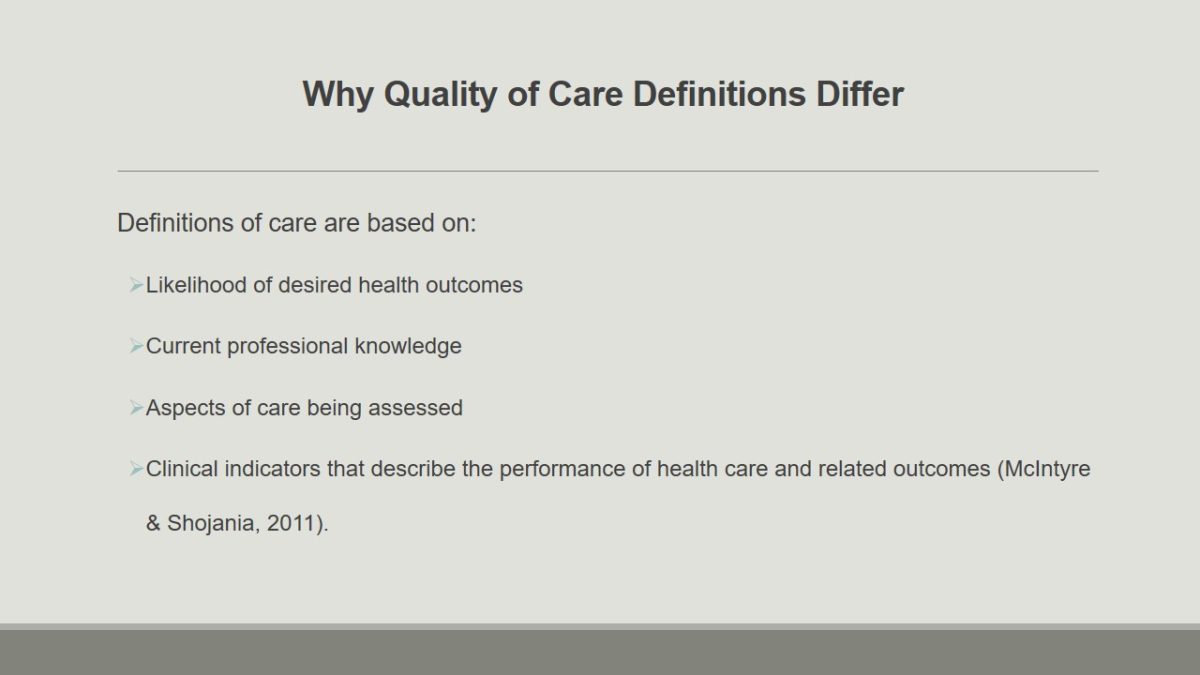
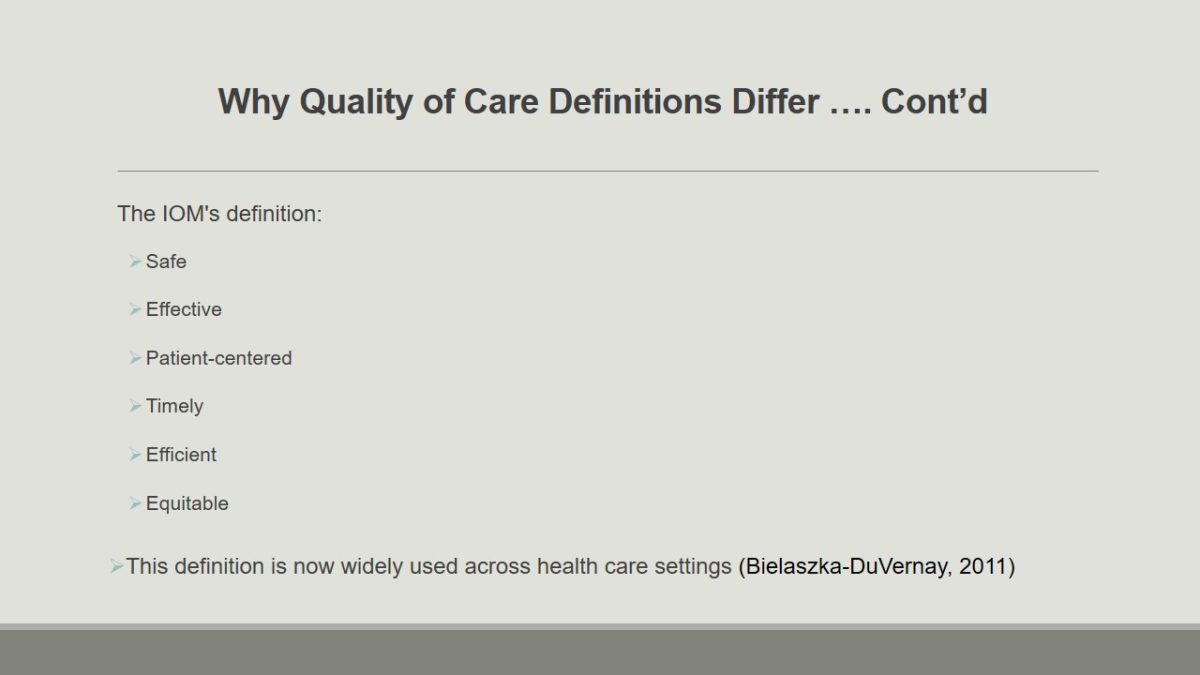
Similarities: Health Care Quality and Manufacturing or Service Quality
- Share similar management concepts:
- Lean management;
- Identifying and removing waste;
- Value addition to customer/patient (Moraros et al., 2016);
- Driven by what the customer or patient wants (patient centerdness, patient engagement, patient experience) (Batalden et al., 2016).
- Encourage value-adding activities.
- TQM
- Originated from the Japanese management style;
- Helps to improve the quality of services and goods;
- Relies on a collaborative approach and standardized performance;
- TQM is driven by:
- A holistic perspective;
- Input from every department and individual;
- Attain standard on customer service and end-user satisfaction;
- Innovative new forms and practices of management (Balasubramanian, 2016).
From a lean management perspective, health care and manufacturing or service industries share similar practices associated with identifying and eliminating wastes. Lean management emanated from the automotive and manufacturing industries, but it is now widely used in the health care setting (Moraros et al., 2016). Value addition and waste reduction are vital for quality processes in which customer or patient is the center of focus. For effective patient participation, patient centerdness, patient engagement, or patient experience, as the process is known, is encouraged with the aim of improving initiatives that are similar to efforts witnessed in the manufacturing or service industries where customers are engaged in designing and marketing products (Batalden et al., 2016).
Based on these principal aspects of TQM, Quality Improvement is fundamental to hospitals because of the focus on quality of outcomes and end users (Balasubramanian, 2016). These are key issues in health care environments.
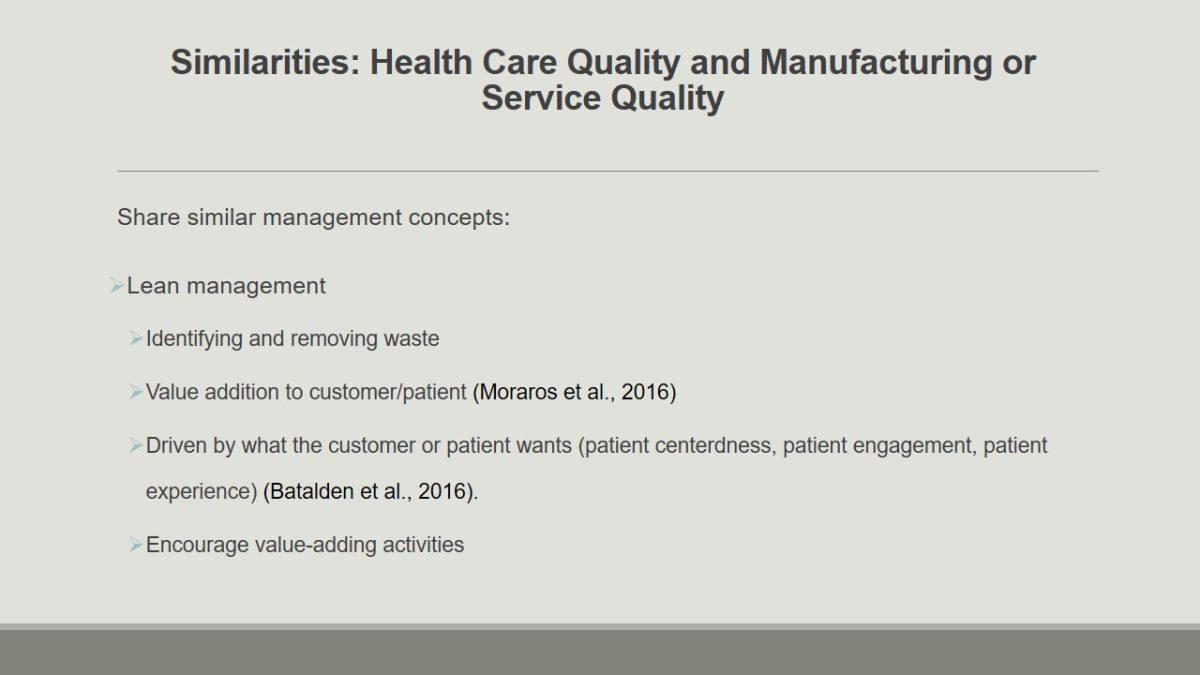
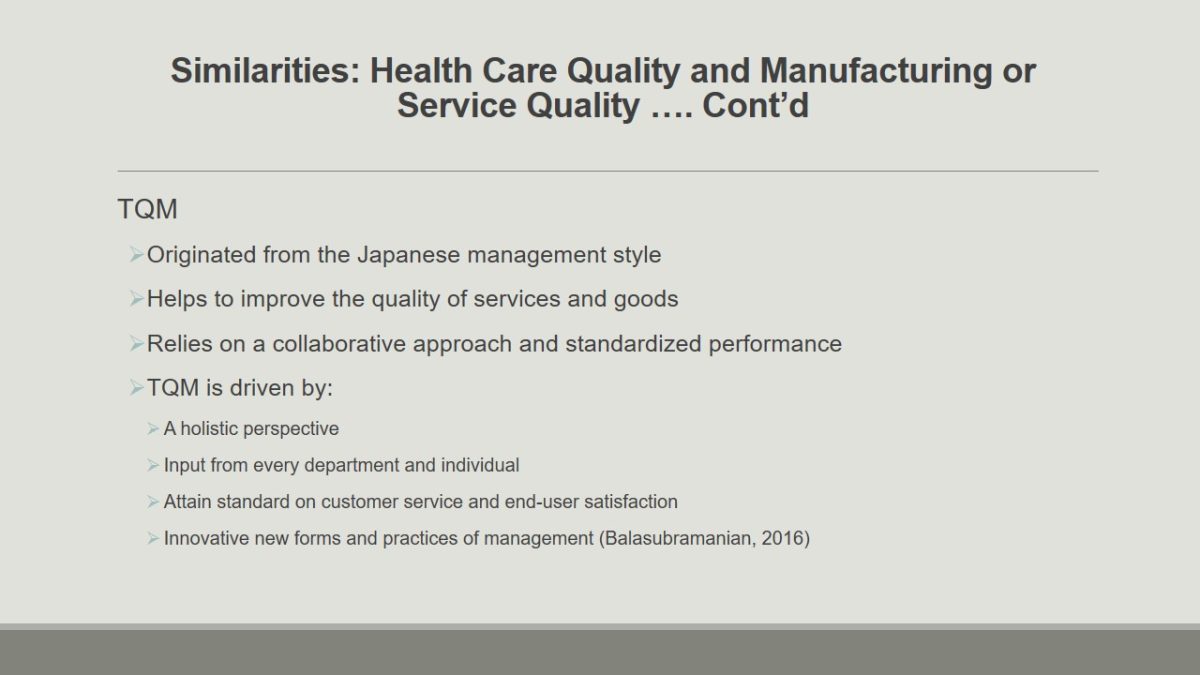
Areas of Health Care Where Nurse Administrators Routinely Monitor for Quality
- The IOM recommends that quality improvements be focused on 20 areas, including:
- Diabetes.
- Care coordination of multiple chronic conditions.
- Major depression.
- Pain control in advanced cancer.
- The National Committee for Quality Assurance:
- Asthma.
- Heart disease (Bielaszka-DuVernay, 2011).
As previously observed, the definitions of quality of care differ based on areas of focus. Hence, more than 20 areas of interests have been identified for Quality improvement by various organizations, such as the IOM and the National Committee for Quality Assurance (Bielaszka-DuVernay, 2011).
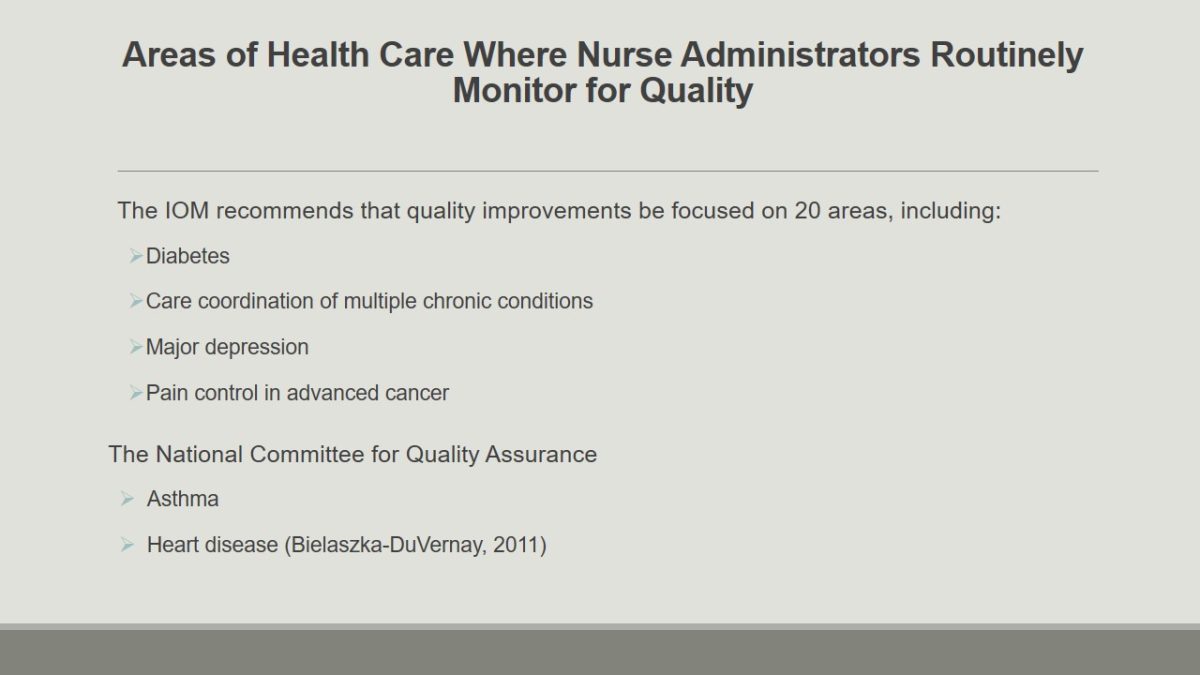
The Accrediting and Regulatory Organizations involved in Quality Improvement and Their Roles
- The Joint Commission – provides accreditation programs and developed National Patient Safety Goals to improve safety.
- National Quality Forum – advancing the quality agenda through standardization of health care performance measures and certification of health care practices and procedures.
- The IOM – recommends areas of quality improvement (Bielaszka-DuVernay, 2011; Marjoua & Bozic, 2012).
- The National Committee for Quality Assurance – offers accreditation and develops Healthcare Effectiveness and Data Information Set standards to track quality and service
- Multistakeholder or public-private collaborations:
- the Hospital Quality Alliance;
- the AQA Alliance;
- collect and report performance measurement data to consumers, physicians, and other stakeholders (Bielaszka-DuVernay, 2011; Greenfield, Pawsey, Hinchcliff, Moldovan, & Braithwaite, 2012).
The existing health care Quality Improvement initiatives have been developed for several years based on cumulative achievements (Marjoua & Bozic, 2012). These bodies have recognized the role of quality of care in advancing patient outcomes. They, therefore, have prioritized health care quality and created various tools to “monitor, quantify, and incentivize quality improvement in the provision of care” (Marjoua & Bozic, 2012, p. 265).
Today, almost every aspect of health care delivery is based on standards, which focus on accreditation and standardized measures. These standards are seen as vital means through which healthcare facilities and care providers can enhance clinical practices and organizational performances (Greenfield, Pawsey, Hinchcliff, Moldovan, & Braithwaite, 2012).
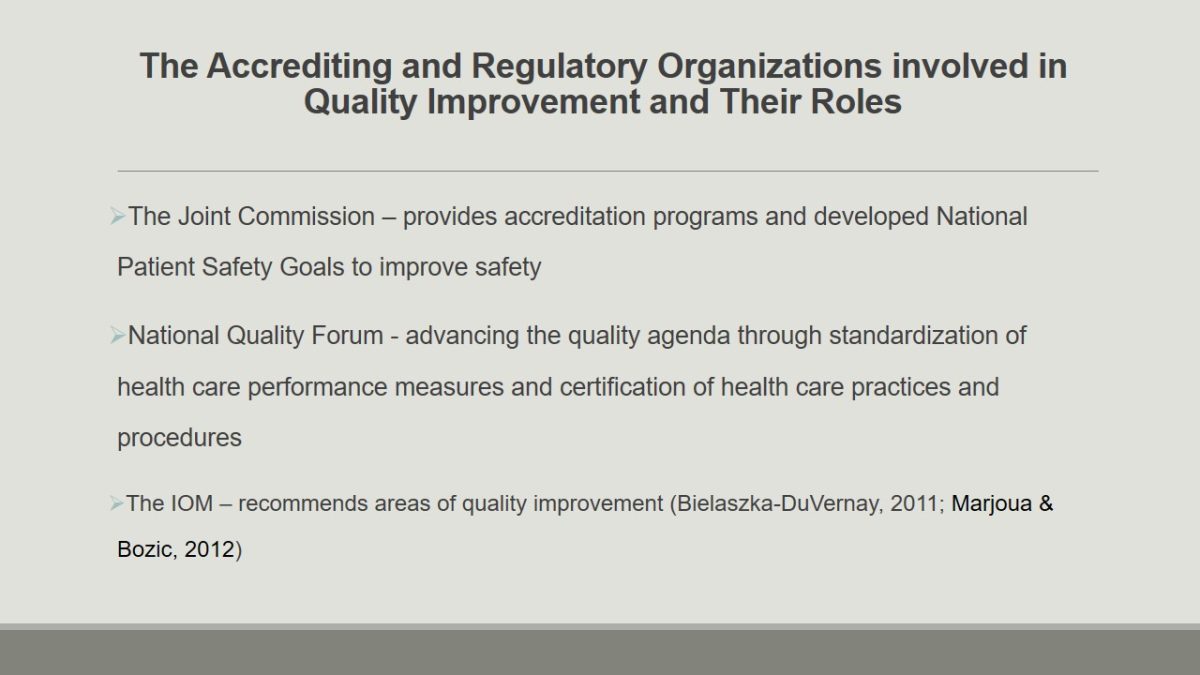

References
Al-Shdaifat, E. A. (2015). Implementation of total quality management in hospitals. Journal of Taibah University Medical Sciences, 10(4), 461–466. Web.
Balasubramanian, M. (2016). Total Quality Management [TQM] in the healthcare industry – Challenges, barriers and implementation developing a framework for TQM implementation in a healthcare setup. Science Journal of Public Health, 4(4), 271-278. Web.
Batalden, M., Batalden, P., Margolis, P., Seid, M., Armstrong, G., Opipari-Arrigan, L., & Hartung, H. (2016). Coproduction of healthcare service. BMJ Quality & Safety, 25(7), 509-517. Web.
Bielaszka-DuVernay, C. (2011). Health policy brief: Improving quality and safety. Health Affairs. Web.